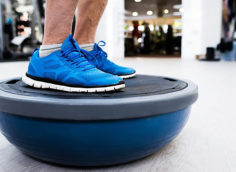Strong, Pain-Free Wrists
Some call it prehab and some call it injury prevention. In reality, it's just how your wrists are supposed to move.
If you're going to lift things, your wrists are going to be involved. This is something that really needs to hit home if you're new to training, but also something that should be maintained and improved as you progress – especially if you can move really heavy loads. I've yet to meet an experienced lifter that hasn't had some kind of wrist pain or injury, whether it was caused by a botched lift or general wear and tear.
But your wrists should NOT be a limiting factor in your strength development. And if they are, that's fixable. Add these exercises into your warm-ups and cooldowns. They'll give you strong, mobile wrists that can withstand the demands of any program.
Oh, you've never hurt your wrist? It's not too crazy an idea to prevent it, especially if you plan to add pounds to the bar. An injury you never get is something worth a little work up-front, and nobody ever says that they wish they didn't have strong wrists.
These stretches will help you to create range of motion in your wrist flexion and extension by using the floor as assistance. If you have tons of wrist extension and zero flexion, your wrists aren't balanced, and your elbows are going to get pissed off in the long-term.
Never force any stretch and always listen to your body. If you notice that your wrists feel tender the next day after doing these, that's your sign to back off a bit. If they're okay then you can start to push a bit further the next time.
If even using the floor is painful, then step it back a bit. These exercises can be regressed by using the wall. Try doing them after a session with a lot of grip work. You'll notice forearm tightness practically disappear within minutes. As a side note, doing "shoulder rotations" in any of these positions also makes for a great warm-up addition.
Radial and ulnar deviation is the side-to-side motion of the wrists. It's neglected by almost everyone. If you practice advanced hand balancing then this is absolutely crucial, and if you do overhead squats or snatch presses, this thumb-grab stretch is an awesome way to alleviate some of the pressure caused by heavy lifting.
For this you're going to try to achieve a position without the added assistance of the floor or wall. You'll probably notice that the range of motion you have control over (active) is drastically different to what you can achieve with assistance (passive). Shortening that gap will greatly decrease your chances of injury. Yes, these drills look slightly ridiculous but when you do them with proper focus they're vital for joint mobility.
You must pull back (in wrist extension) as far as you physically can before adding the finger extensions. When you've done three, then try to pull back even further. Make sure to block off your elbow as it likes to try and get involved and help out.
Taking this drill seriously and doing it properly will really help you to own those positions and build strength. If you half-ass it you may as well just pretend to fondle an invisible person.
There comes a point with all mobility exercises when you need that little extra push. Just like one of the best ways to increase your pull-ups is to add weight and variety, the wrists are no different; that extra stimulus adds crazy strength.
Seems like almost every guy at the age of 16 has acquired a set of changeable dumbbells. If you still have them, remove all the plates from one side and put just the smaller plates on the other. This makes a nice tool for wrist exercises. Don't have changeable dumbbells? Grab a sledgehammer. You can get creative with it and increase the difficulty by moving your hand further down the handle. Just be careful of your face.
Rotate between supination (palms up) and pronation (palms down). This is a real burner on the forearms, and again, don't neglect your radial and ulnar deviation.
Light weight and high reps is the best way to go with these exercises. Three sets of fifteen each arm is great. Even if you don't really want to dedicate part of your session to it, you can just throw it in when resting between sets of squats. It's not that taxing so it won't be detrimental to your next set, unless it's one-rep max day.
These exercises are NOT for beginners and should be supervised by a coach who does them. This is just an example of long-term progressive build-up.
You may see fighters doing this kind of drill. In contact martial arts, it's important to strengthen your wrists for fighting and grappling. With submissions and holds, nothing sucks more than when you're sparring with someone and they have a crazy-strong grip. For striking, your wrists also need to be able to take impact as people don't tend to stand still when you're punching them. Dodgy punches happen.
Weightlifters who apply these same wrist-strengthening methods will significantly reduce their risk of injury and also increase the training they can endure. There's nothing that annoys me more than when someone can't complete sets of weights they should be fully capable of doing because their wrists can't take the pressure.
If you've really owned the passive stretches and they feel easy to you, then it's time to step it up. First, test it from your knees. See if you can you support your weight in full wrist flexion. If there's no discomfort then attempt a push-up slowly. Again, only try a few and see how your wrists feel the next day.
Over time exercises like this won't become a big deal and you can just add them to a list of "things you can do." But the added benefit of having iron wrists will stay with you, and it's nice to take that for granted.





